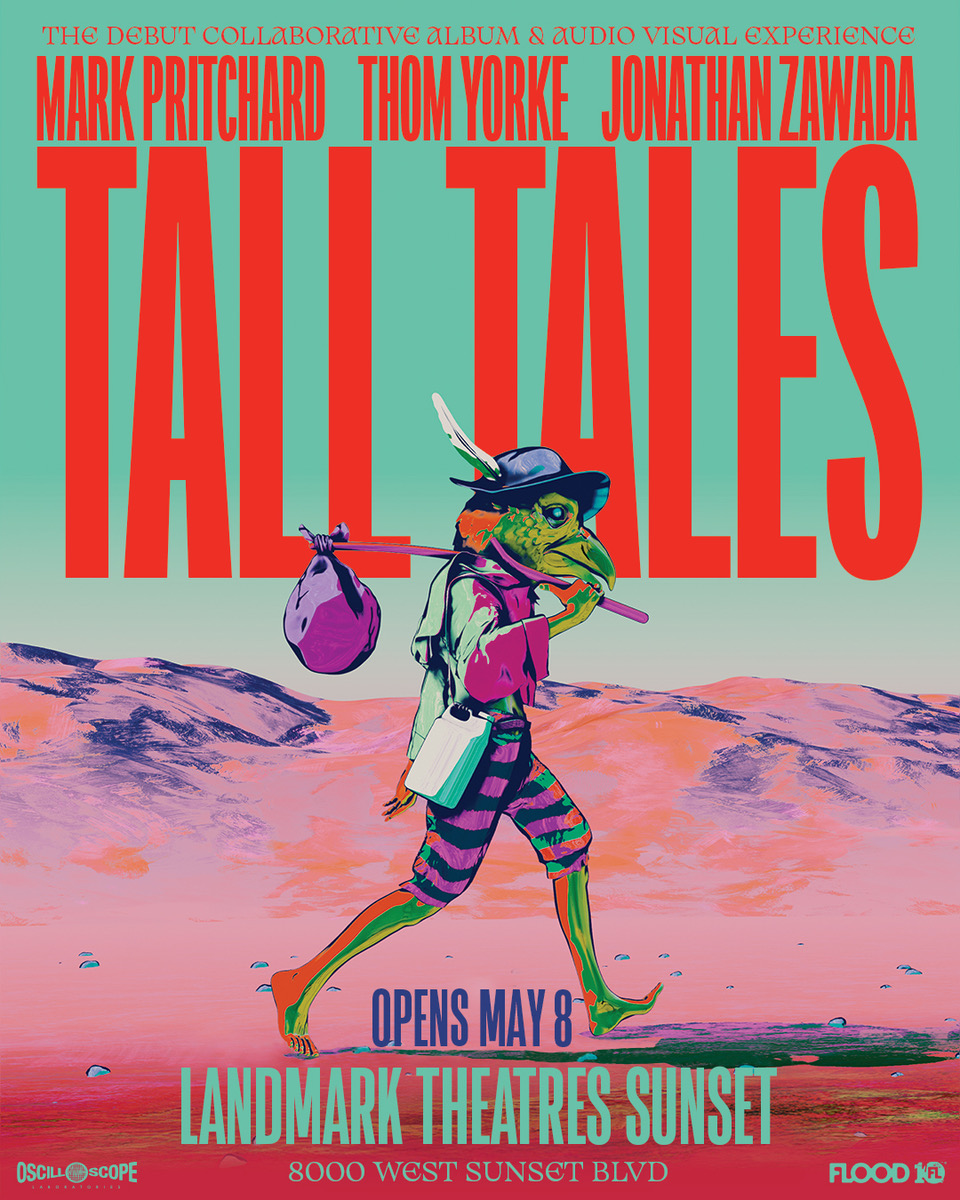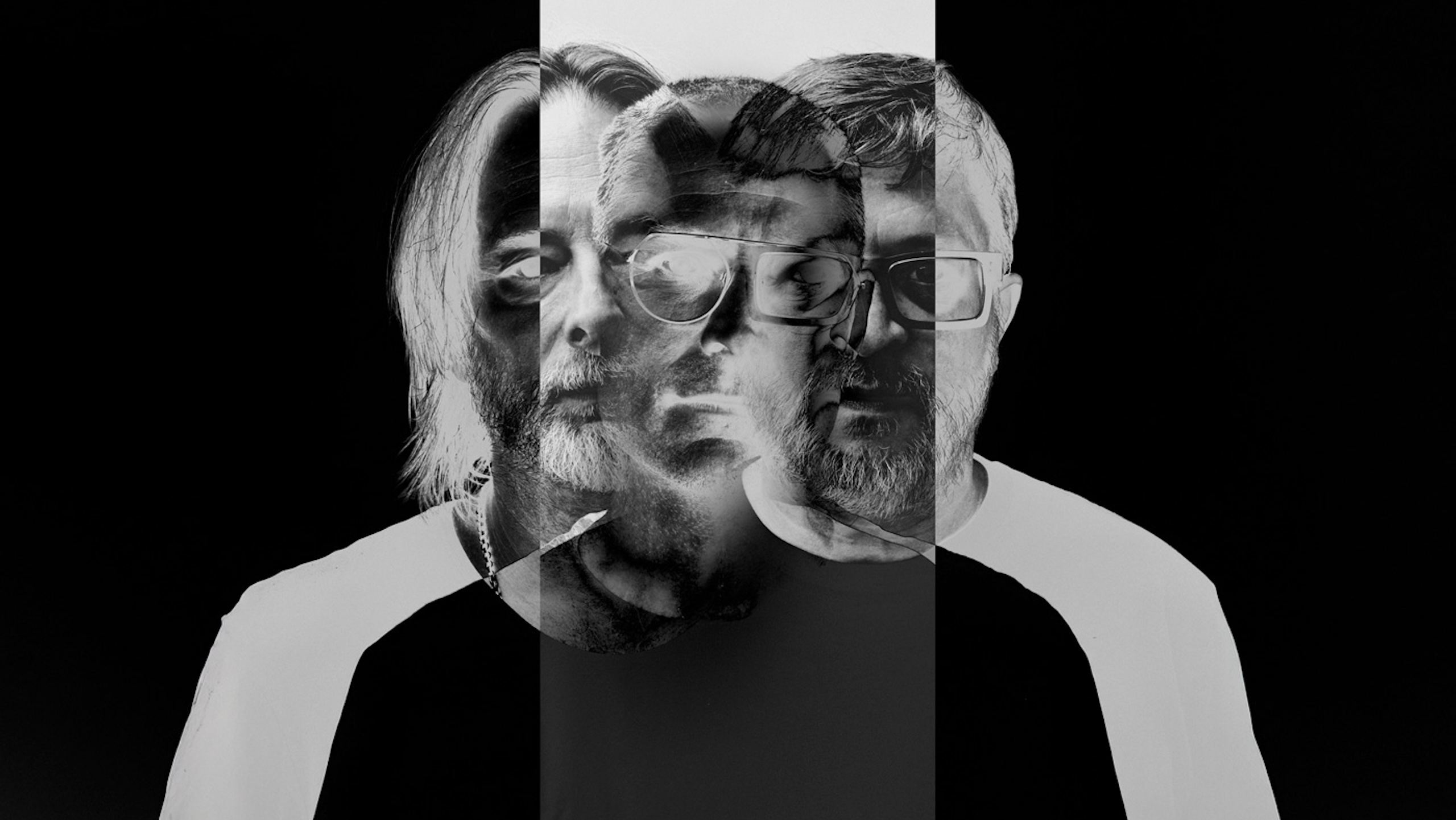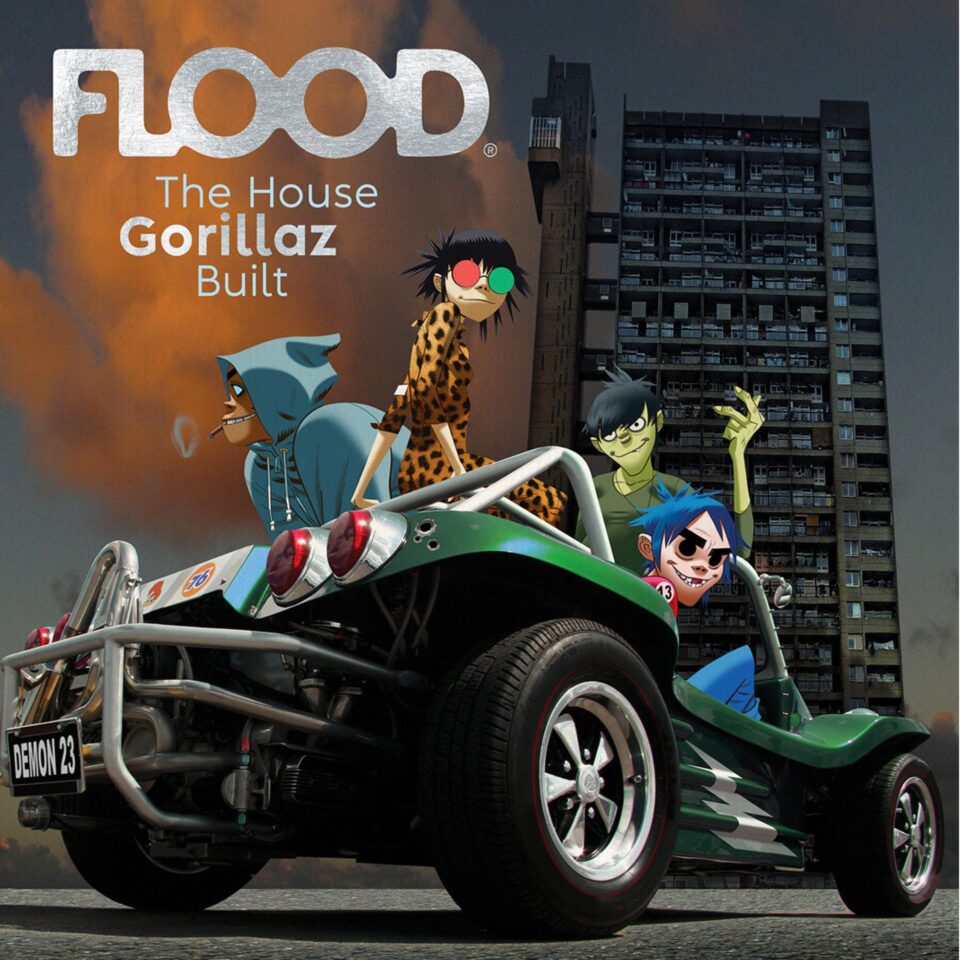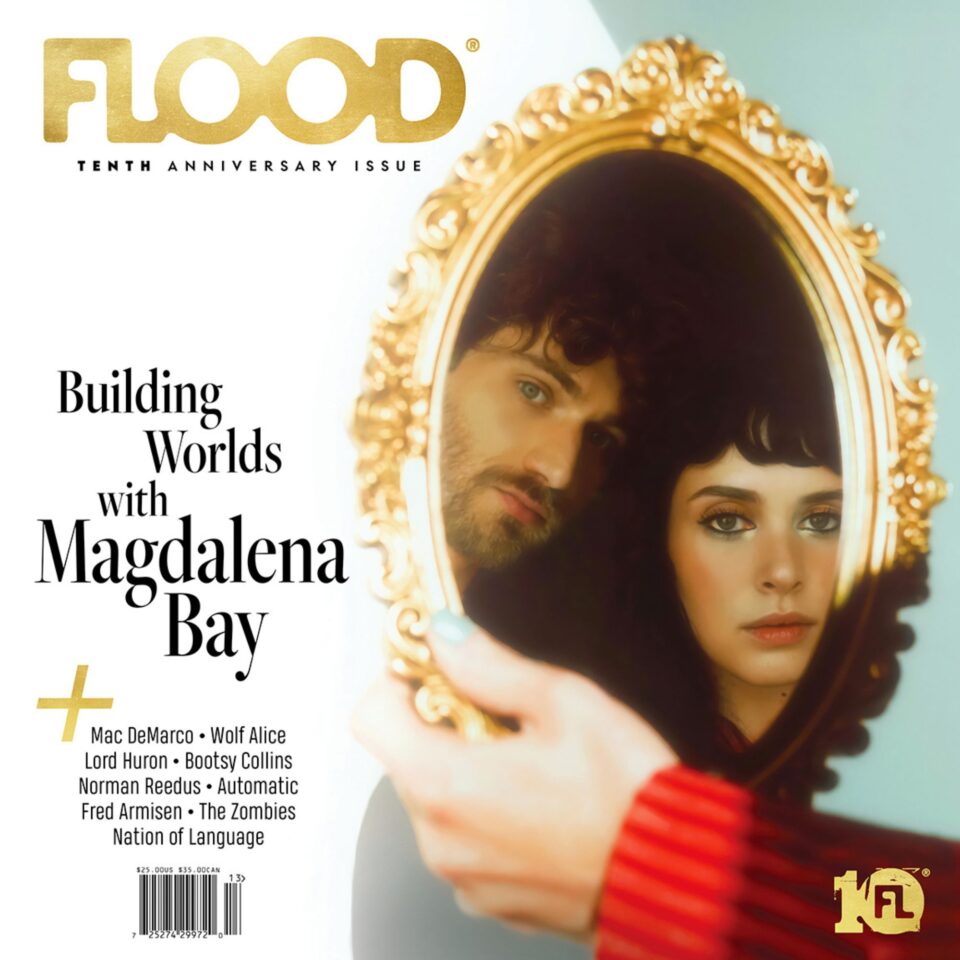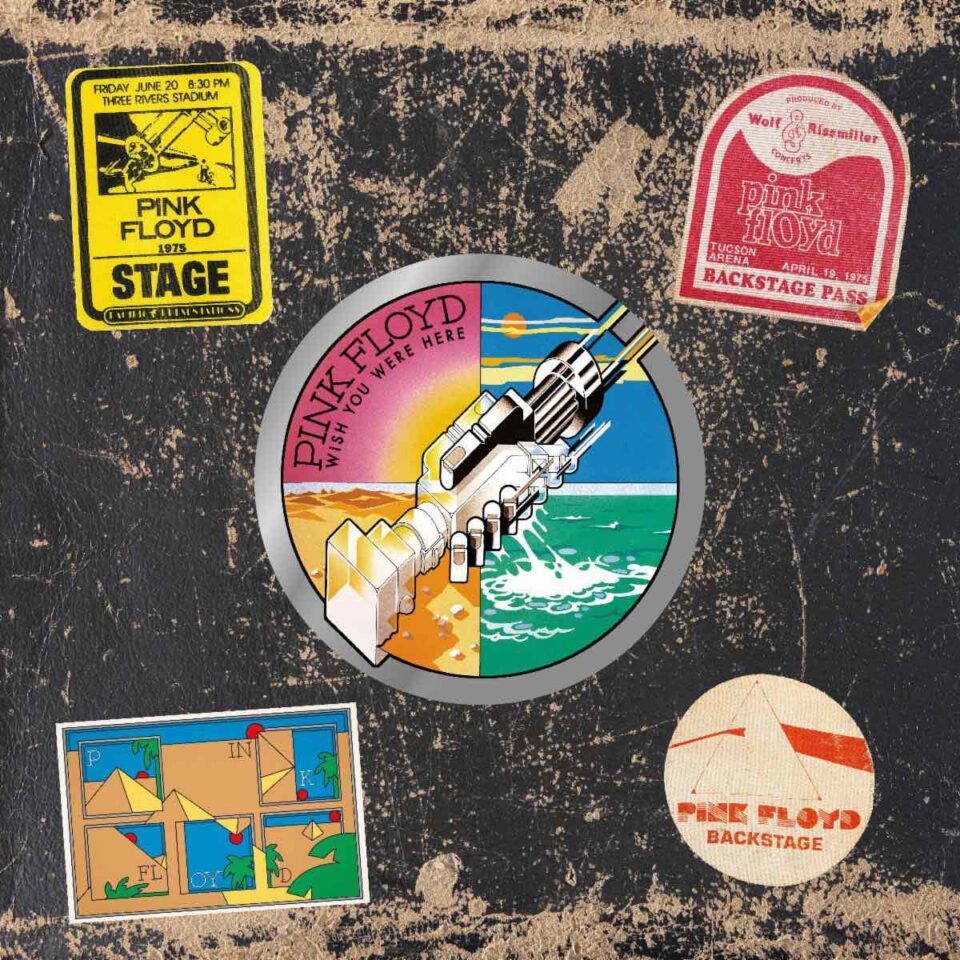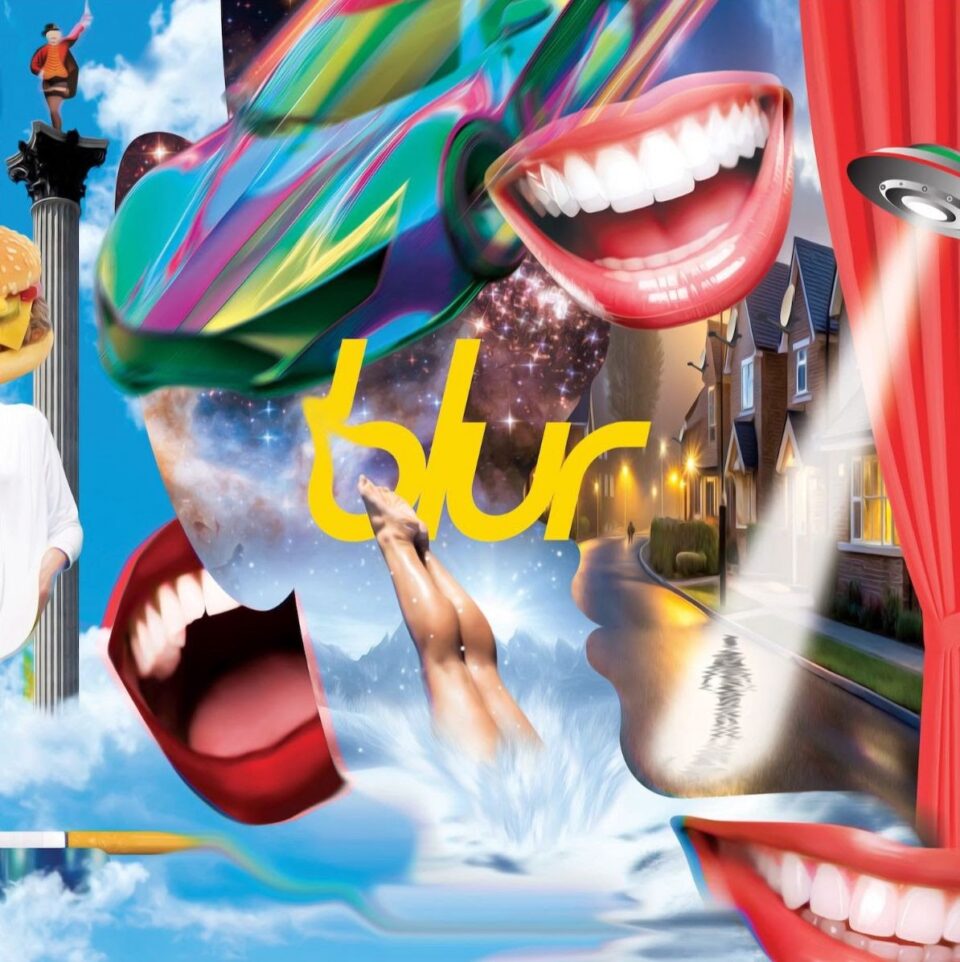FLOOD is sponsoring the Tall Tales visual experience screening in Los Angeles on May 8 at Landmark Theatres Sunset. Tickets are on sale now here. Visit the official site for additional screenings around the world.
If I told you that Thom Yorke just made some of the most melancholically gorgeous music of his career and set its lyrical fictions regarding art theft, replication, and false idolism to film-animation—provocatively bold in color and restless imagination—you might call it a tall tale. Which may be why Yorke, along with musical collaborator Mark Pritchard and filmmaker Jonathan Zawada, beat you to the punch. The duo’s album Tall Tales will be released on May 9 through Warp Records. A day earlier, its same-named, analog-meets-digital-meets-AI animated feature film, directed by Zawada, screens for one night only in cinemas.
Both the album and the film have a definite narrative throughline, even if the film’s director has his doubts. “I wouldn’t have thought I was a filmmaker before this,” says Zawada from his London studio during our Zoom conversation about his leap from shorts, music videos, and installation visuals to his new hour-plus cinematic experience. “I always thought of myself as rather more of a worldbuilder. The concepts are there in Tall Tales, but it doesn’t work without its music. My opinion was that they should release the album first, then the film—that’s how brilliant I believe the album is. So, much of the emotion in this comes from the careful balance of those sounds and the things that pull your brain in different directions.”
Zawada was brought into the Tall Tales project as he and Pritchard are longtime friends and have a shorthand based on their previous work together—as do Pritchard and Yorke, from their past collaboration on 2016’s “Beautiful People.” “Whatever this was going to be, I knew I wanted Jonathan involved,” says Pritchard. “He was into the music straight away. That’s always the greatest signal: how nuts he goes over the material. If you’re working with someone talented such as Jonathan, you want them to [have] the freedom to do what they want.”
“What I liked about Mark from the start is that he changes his name often throughout several different projects, as well as his musical styles,” says Zawada, pointing out previous Pritchardisms such as Global Communication, Jedi Knights, Shaft, and Harmonic 33. “That resonated with me, as we live in a time, creatively, where we’re expected to stay in our lanes, and he doesn’t do that,” says the director. “And Mark approached all of these different musical genres with equal rigor while maintaining his own artistic identity with each project. He goes out on a limb. My own creative career has been like that, to this point.”
“I always thought of myself as rather more of a worldbuilder. The concepts are there in Tall Tales, but it doesn’t work without its music.” — Jonathan Zawada
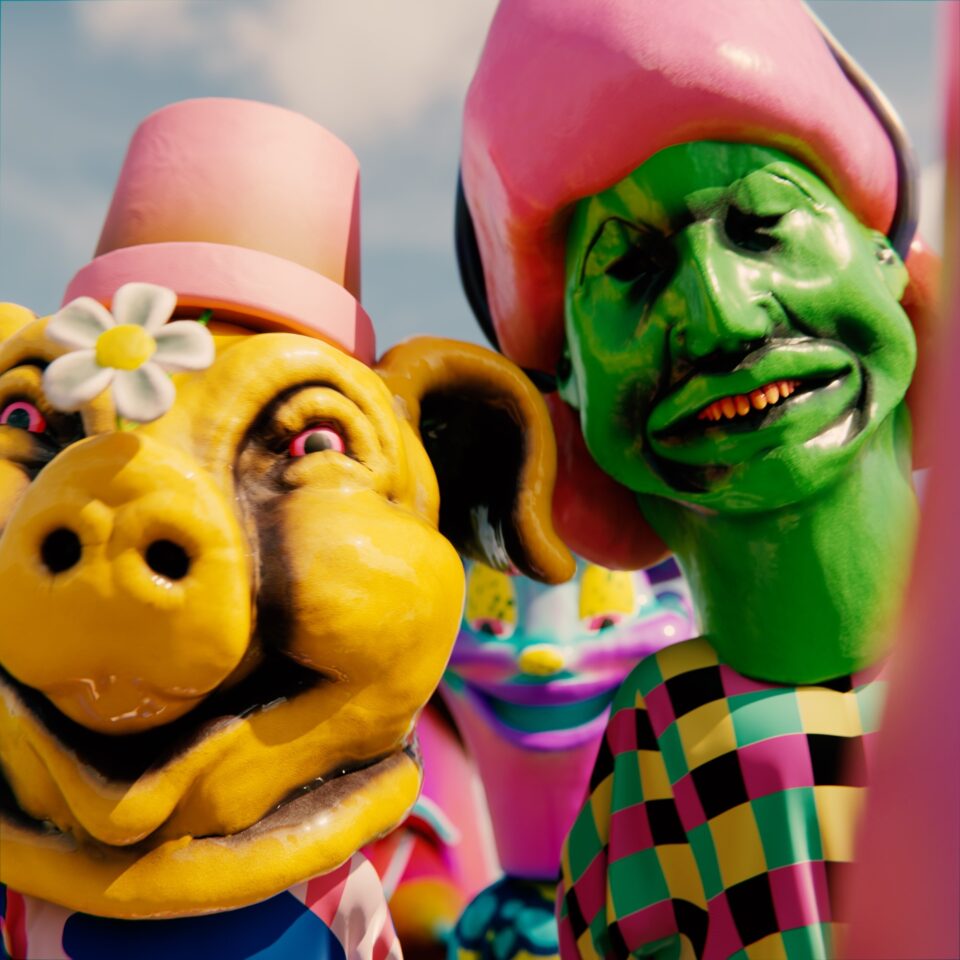
Zawada’s creative career has been marked by its tactile blending of the analog and the digital realms, with large dollops of naturalism within his spaced-out vision—to say nothing of his inclusion of AI into his daily catalog of expression. “I’d been using it off and on since 2015, when I did an art installation in Beijing that used AI systems as its topic,” he says. “I like technology and have enjoyed playing with generative adversarial network image generation from that point on.” Several of Zawada’s 2018 music videos for The Avalanches are heavily invested in AI tool-made vision, long before the controversial behemoth it’s become. With that, AI is as much an organic part of his work as clay would be to a sculptor. “It’s grown with me,” says Zawada.
Once you include the sight and feel of nature into his picture, literal and figurative, another Zawada vision comes about, one explosive with bold, bright color. To that, the Tall Tales project is synonymous with the rest of Zawada’s recent catalog, as well as acting as an anomaly to his usual vision. “There was so much to draw upon already from their mood, their music, its lyrical content, and the inspirational material that Thom had, and fed into this world of other things, that I didn’t feel the need to refer back to my past work or pick up from there,” says Zawada. “It felt like totally fertile new ground.”

It would be easy to glean from the song titles “A Fake in a Faker’s World” and “This Conversation Is Missing Your Voice” that Tall Tales traffics in falsity in news and art, questioning the definition of self-owned, self-made images when AI is afoot. But Zawada’s repetitious images of countless robot arms, outstretched and holding paintbrushes over countless Warhol Maos—itself a longtime issue of replication and fakery that made Pop Art controversial—digs an even deeper grave for the topic of fake news. “There was a conversation among the three of us early on where ideas of forgery versus authenticity, along with human labor and the values we place on the things we create, came up,” says Zawada. “Thom also expressed how what he wrote for ‘The Men Who Dance in Stag’s Heads’ was inspired by Benjamin Myers’ The Gallows Pole and its historical-fictitious take on the greatest economic fraud in Britain.”
Even one of Zawada’s images for the cover of Tall Tales—a Thinker statue stolen and cut-up by its thieves with the intent of selling its valuable copper—deals in the value of art. Between that and the forgeries of The Gallows Pole, Yorke spoke about how these phenomena relate to a broader society. “That triggered many of my similar thoughts, and that—compounded by the trajectory of AI—made all of the questions of fakery grow larger on the album and the film,” says Zawada of the perspective-shifting narratives and the random values we attach to random things. “Some things must be unique. Some things we don’t care if they’re replicated at all. We want a world where everyone benefits, yet at the same time, we want to preserve a world where only some people can have access to certain pieces of art work, and despise when those get replicated. These things pull your mind in different directions.”
The director says that when he became the visual part of the trio, his collaborators were still mailing unfinished tracks to each other in various states of completion, remaining open to third opinions. “Thom, from the very beginning, seemed receptive to Mark’s idea of bringing me in for visual accompaniment,” states Zawada, adding that rather than handing him songs to go off and render cinematically on his own, the trio developed another brand of back-and-forth where the composers played off Zawada’s Technicolor vision and parlayed back to the music-makers. “There were definitely occasions within the process where they saw another way into how their songs could work after seeing the visuals,” Zawada confirms. And posing questions, as opposed to giving solid answers, also makes their joined aesthetic percolate. “Mark and I spoke of this,” Zawada says, “how we’re asking questions while being aware of the complexity of things at a time when so many people are absolutists. Like, AI is bad or good, when you and I know, it’s both.” Or neither.
“In the wrong hands, this could’ve wound up as quite garish... Jonathan’s take on it—his layers—takes it to yet another place, which is why I wanted him to work on this.” — Mark Pritchard
And while we’re asking questions, what the heck is that beaked character doing pacing throughout Tall Tales’ various scenes like a tour guide on walkabout? Why is it bird-like? What’s in their sack? “That character came out of my early thoughts of having Thom appear in some of the videos, where he’d be sitting on a ferry boat with a prosthetic beak on, getting dragged off to some little island,” Zawada laughs. “That never got fully resolved, so this character became an emblem for the universe we created—someone finding themselves in a strange environment, having to come to terms with the systems happening in that world. Thom, Mark, and I did see connective threads to what we were making, even if we didn’t always have all the same stories.”
“The animation bird is quite playful,” adds Pritchard. “A nice addition to the rest of the stuff and its heavy mood. It has a computer-game vibe and a Disney-like cheekiness to it. That madness reminds me of the children’s programs of our youth in the UK.”
Beyond the bird, bringing up Zawada’s wash of bold colors—something surprising, even radical, when issues of fake news are at hand within lyrics and descending, crushed chords—reminds Pritchard of the balancing act Tall Tales truly became. “I’m not an artist, so I won’t guess about Jonathan’s use of mad color. In the wrong hands, this could’ve wound up as quite garish. And what it does for my music is quite unusual. For the sound, the melodies, I tried to balance the heavy against the light on the album with its sequencing, and the difference in Thom’s vocals, but Jonathan’s take on all that—his layers—takes it to yet another place, which is why I wanted him to work on this.”
“Thom, Mark, and I did see connective threads to what we were making, even if we didn’t always have all the same stories.” — Jonathan Zawada
Pritchard also mentions how the difference in their ages (“Jonathan’s at least five to 10 years younger than me”) made a difference in how references are applied, and how contemporary the whole of Tall Tales became. “What Jonathan did made what Thom and I did modern in a very subtle way,” says Pritchard. The oddball nature-ism, its splashy color, and the bold digi-analog look that Zawada provided their music “intrigued Thom to no end, as it did me,” he says. “These visuals are a world unto itself.”
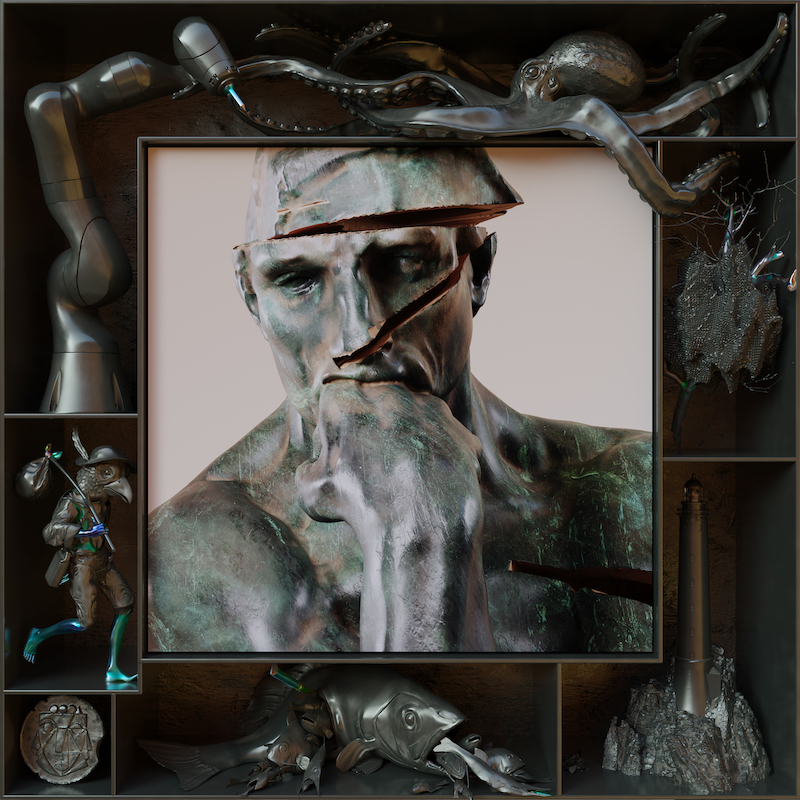
Going back to the start of the Tall Tales project, when Pritchard began these tracks in his studio, the producer states that such pensive, beautiful melodies and unsteadying rhythms were part of a day’s work in the office. “‘Wandering Genie’ is 10 years old. Several tracks could’ve remained ambient pieces. Some of what I came up with, I had in consideration for what could be my next solo album, with various differing vocalists, maybe. I don’t even know if Thom would’ve been part of that process until I sent him a few random tracks.”
As for the untrusting themes running rampant in Yorke’s lyrics and Zawada’s images, the devaluing art/AI fakery aspect of Tall Tales is something that built its own head of steam and posed its own set of questions that should intrigue everyone who welcomes this film/album package. “There were one or two things that were clear and not open to interpretation—maybe the clearest and straightest Thom’s ever been—but I had to guess at what the rest of the lyrics were about, sent those ideas to Thom, and he said that I got about 90 percent of them correct,” laughs Pritchard. “The things that were upfront, Jonathan and I didn’t obscure. The other things, we took it right to the line and made our own subtle differences—and no matter what, our versions of that, musically and visually, were never obvious.” FL
